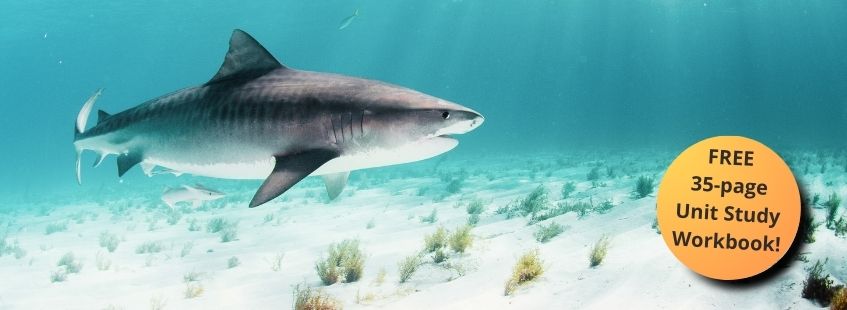Do you have a little one who loves sharks? This unit study is for you! July is the home of the ever-popular Shark Week, so we thought this would be a great time to deliver this exciting study for you and your family. This shark unit study is best suited for PreK-5th grades.
Download your free Shark homeschool unit study ebook at the bottom of this article.
Shark Homeschool Unit Study Book List
Nonfiction:
- The Ultimate Book of Sharks by National Geographic Kids
- Sharks for Kids: A Junior Scientist’s Guide to Great Whites, Hammerheads, and Other Sharks in the Sea by David McGuire
- Sharks!: 100 Fun Facts About These Fin-Tastic Fish by Stephanie Warren Drimmer
- Kids’ Guides: Exploring Sharks by Hello, World!
- Shark Lady: The True Story of How Eugenie Clark Became the Ocean’s Most Fearless Scientist by Jess Keating
- Children’s Encyclopedia of Sharks by Claudia Martin
- Can’t Get Enough Shark Stuff: Fun Facts, Awesome Info, Cool Games, Silly Jokes, and More! by Andrea Silen
- Hark! A Shark!: All About Sharks (Cat in the Hat’s Learning Library) by Bonnie Worth
- Amazing Sharks! (I Can Read Level 2) by Sarah L. Thomson
- The Ultimate Shark Field Guide: The Ocean Explorer’s Handbook by Thomas Nelson
Fiction:
- Clark the Shark by Bruce Hale
- Spark the Happy Shark by Alisa Swenson
- Stella: The Shark Who Loves Treasure by Sarah Cullen and Carmen Ellis
- Hammy Hammerhead’s (almost) Big Adventure! by Mike Crowder
- Hungry Shark chapter books by Ace Landers: Shark Out of Water! and Eye of the Tiger Shark
- How to Make a Shark Smile by Shawn Achor and Amy Blankson
- The Great Shark Mystery (The Boxcar Children) by Gertrude Chandler Warner
- What If We Had A Pet Shark? by Deanna Chesley
- Julia and the Shark by Kiran Millwood Hargrave
- Mother of Sharks by Melissa Cristina Márquez
Activity Books:
- Sharks Sticker Activity Book by National Geographic Kids
- Scratch & Sketch Sharks by Peter Pauper Press
- How to Draw Sharks: Step-by-Step Drawings! by Arkady Roytman
- Fun with Sharks Stencils by Paul E. Kennedy
- The World of Sharks Undersea Facts and Activity Book by Gold Stars
Fun Facts About Sharks
There is so much to learn about sharks! How many of these did you already know?
- There are over 500 different types of sharks in the world!
- Sharks live in oceans all around the world – deep water, shallow water, warm water, cold water – it doesn’t matter! Indeed, sharks are everywhere in the ocean!
- Sharks are fish, not mammals. In fact, they get their oxygen from the water instead of from the air like whales.
- The Dwarf Lantern shark found in South America is the smallest shark species. So small it’s smaller than a human hand!
- The largest shark by far is the Whale shark. It can weigh up to 40 tons – that’s 80,000 pounds!
- Basking sharks come in 2nd in the largest shark category growing up to 32 feet and 5 tons.
- The slowest-moving fish ever recorded is the Greenland shark, swimming slower than a human walks.
- Sharks have no bones! Their skeleton is made of cartilage which is why no shark fossils are ever found (except teeth). Their light cartilage skeleton keeps them buoyant in the water.
- A shark’s dorsal fin (top fin) keeps the shark swimming in a straight line.
- If you touch a shark, its skin feels like sandpaper due to the dermal denticles (tiny “skin teeth”) that help reduce friction while the shark is swimming.

- Most sharks are white, gray, or black, but some are blue…and some are even pink!
- The only place a Hammerhead shark has a blind spot is directly above and below its head.
- Sharks have a sixth sense! In addition to touch, taste, sight, sound, and smell, they can also sense electricity in the water. Because of this, they can tell when their prey is hiding in the mud even if they can’t see, smell, or hear them. They’re able to do this because of a special organ known as the Ampullae of Lorenzini.
- Sharks can smell a single drop of blood from up to a third of a mile (or 1760 feet) away.
- Baby sharks are called pups and are born with a full set of teeth.
- Sharks typically lose one tooth per week and can replace a lost tooth within a day. They lose them so frequently because their teeth do not have roots, so they come out when they’re eating.
- You may be surprised to learn that the shark with the greatest bite force is not the Great White, but the Bull shark. It bites with a force of 5,914 Newtons. Combining this with the fact that Bull sharks are also quite aggressive, they are one of the most dangerous sharks in the ocean!
- Sharks are known as apex predators. This means they are at the top of the marine food chain and have no natural predators.
- Sharks don’t chew their food. Instead, they rip off chunks of meat and swallow them whole. Some of their favorite foods include fish, other sharks, rays, sea lions, seals, and even sea turtles!
- When they’re hunting, sharks go under their prey, swim up very quickly, burst out of the water (called breaching), and fall back into the water with the prey in their mouth.
- Some sharks give birth to live babies while other shark breeds lay eggs.
- Shark parents do not take care of their babies. Therefore, as soon as they are born, the pups are on their own!
- A blue shark can have more than 100 pups at one time!
- A Great White shark usually has 2-10 babies at a time.
- Most sharks live 20-30 years. In fact, a Whale shark can live to 100, but Greenland sharks can live 400 years!
- When people are asked about their fears, fear of sharks is one of the most common.
- Shark attacks are actually very rare. In fact, there are usually only 5-10 per year.
- Even more, the biggest threat to sharks is humans. Shark fin soup is considered a delicacy and thousands of sharks are harvested for their fins every year.
- Most shark breeds are social and can be found in large groups, or schools.
- Some sharks have to be continually swimming, moving water over their gills to breathe. If they stop moving, they can suffocate and die.
- If a shark is flipped upside down, it goes into a trance-like state known as tonic immobility.
- The fastest shark in the ocean is the short-fin mako shark, swimming up to 46 miles per hour!
- Most sharks are cold-blooded like the water they swim in, but some, like the Great White, are warm-blooded.
Shark Homeschool Unit Study Activities
- Why Do Sharks Not Sink?: Try this fun science lesson on sharks and buoyancy to drive this fact home for your little ones! As mentioned in the Fun Facts, a shark’s skeleton is not made of bone but is made of cartilage. Cartilage is much lighter than
 bone and helps the sharks float in the water. Another way a shark’s body is built for buoyancy is the fact its liver is large and filled with oil. For this activity, first get two small water bottles to represent sharks. Also, if you want to add an additional step, either you or your kids can decorate them with a Sharpie. Then, fill each bottle equally, one with cooking oil and one with water. Next, fill a large clear bucket with water and ask your child what he thinks will happen when the oil and water bottles are added. Finally, let them drop each water bottle into the water. Just like the oil bottle floats, a shark’s oily liver helps it to float as well! To add a bit of fun, add a plastic shark to the bucket and let your kid have some water fun!
bone and helps the sharks float in the water. Another way a shark’s body is built for buoyancy is the fact its liver is large and filled with oil. For this activity, first get two small water bottles to represent sharks. Also, if you want to add an additional step, either you or your kids can decorate them with a Sharpie. Then, fill each bottle equally, one with cooking oil and one with water. Next, fill a large clear bucket with water and ask your child what he thinks will happen when the oil and water bottles are added. Finally, let them drop each water bottle into the water. Just like the oil bottle floats, a shark’s oily liver helps it to float as well! To add a bit of fun, add a plastic shark to the bucket and let your kid have some water fun! - Feed the Shark Play-Dough Geometry: For this activity, you need play-dough, black and white paper, googly eyes, and gummy fish. First, use the white paper to cut out small triangles for the shark’s teeth and use the black paper to cut larger triangles for the shark’s fins. Next, form the shark using the play-dough (gray or blue would be the most accurate, although if your kid would rather make a pink or green shark, who are we to stifle their creativity?!), and give him a large, open mouth. Add the teeth and fins. Finally, once your shark is ready, feed him with the gummy fish!
- Make some Shark Slime: For this fun activity your kids are sure to enjoy, you need 6 oz of blue glitter glue, 1/2 teaspoon of baking soda, 1 1/2 tablespoons of contact solution, and toy sharks. Start by squeezing the glue into a small bowl. Next add the baking soda and then the contact solution. Mix it all together until the mixture doesn’t move. Knead the slime with your hands to make sure everything is thoroughly mixed. If the slime is still too sticky, add in a little contact solution and mix again. Repeat as necessary until you reach your desired consistency. Lastly, add in the toy sharks and enjoy! Also, this slime can be stored in an airtight container to be played with again.
Shark Snacks
- Shark Snack Cups: To make these cute shark cups, you need clear plastic cups, one 8 oz. tub of thawed whipped topping, 2 6 oz. containers of vanilla yogurt, 1/4 cup of boiling water, 1 box of berry blue Jello mix, 1/2 cup of graham cracker crumbs, and gummy sharks. Then, add the boiling water and Jello to a bowl and mix until Jello dissolves. Next, whisk in the whipped topping container and the vanilla yogurt until mixed. Spoon the mixture into individual cups. Add a spoonful of graham cracker crumbs to one side. Freeze for 3 hours or until firm. Remove cups from freezer 15 minutes before serving, and add the gummy shark to the “water.” If you want an additional presentation element, add a parasol umbrella to the graham cracker “beach.”
- Make a Watermelon Shark: First, cut a third of a watermelon off of one side. Draw an oval on one corner of the remaining watermelon. Cut out the oval and scoop out the watermelon. Use a knife to draw teeth on the edge of the oval. Add a toothpick with a blueberry on either side for the eyes. You can fill the watermelon with either the scooped-out watermelon or other fruit. Finally, enjoy!
- Make Shark Popsicles: On these hot days, enjoy a cool shark-themed treat! All you need is a liquid – white or blue sports drink, lemonade, flat Sprite, or even water! – shark gummies, and either a popsicle mold or even just a cup and popsicle stick! To start, place the shark in the mold, add the liquid and the stick. Then, use the stick to push the shark against the side to hold it in place. Place in the freezer until solid.
Shark Learning Videos




